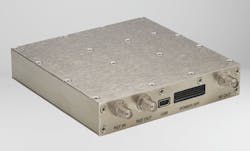Frequency synthesizers—along with many other RF/microwave test-and-measurement functions—have been undergoing a metamorphosis of sorts, transforming from large and expensive benchtop instruments into smaller, modular units that require external power supplies and controls. The model FSL-0010 from Phase Matrix is one such “next-generation” frequency synthesizer, offering full-sized performance from 650 MHz to 10 GHz in a housing measuring just 4.0 x 4.0 x 0.8 in. The small housing doesn’t shrink the electrical performance of this unit, however, which can hold its own against much-larger, more-expensive frequency synthesizers.
The FSL-0010 (see figure) is the latest addition to the QuickSyn® line of modular frequency synthesizers from Phase Matrix, although it is less than one-half the size of the company’s earlier 10- and 20-GHz frequency synthesizers. The tiny FSL-0010 includesUniversal-Serial-Bus (USB) and serial-peripheral-interface (SPI) connectors for control with a personal computer (PC) and requires only connection to a power supply and a PC for operation. A soft front panel appearing on the PC allows a user access to different operating modes, such as list mode and frequency sweep mode. The diminutive frequency synthesizer tunes with 0.001-Hz frequency resolution across its frequency range, with frequency stability matching that of its (internal or external) frequency reference source. It boasts 100-μs frequency switching speed using triggered list mode (it can select from as many as 32,000 points in list mode) and 200-μs frequency switching speed under the control of individual SPI commands.
Although the FSL-0010 is a fraction of the size of traditional bench-top, instrument-grade frequency synthesizers, it packs the essential performance needed for high-quality test-signal generation into its compact housing. Typical harmonic levels are -12 dBc for output signal levels at a minimum of +15 dBm and typically at +18 dBm. Nonharmonic spurious signal levels reach a maximum of -60 dBc and are typically at -70 dBc. The output return loss is typically -10 dB.
Phase noise is impressive for the FSL-0010, across its full bandwidth and whether measured close to or from far the carrier. The phase noise is typically -126 dBc/Hz offset 1 kHz from a 0.65-GHz carrier and typically -104 dBc/Hz offset 1 kHz from a 10-GHz carrier. The phase noise drops to -138 dBc/Hz offset 10 kHz from a 0.65-GHz carrier and typically -117 dBc/Hz offset 10 kHz from a 10-GHz carrier. The FSL-0010 synthesizer maintains that low phase noise further from the carrier, with phase noise of -138 dBc/Hz offset 100 kHz from a 0.65-GHz carrier and typically -117 dBc/Hz offset 100 kHz from a 10-GHz carrier.
The FSL-0010 is equipped with an internal 10-MHz frequency reference which provides a nominal output level of +5 dBm (flat within ±2 dB) for operation with the synthesizer’s circuitry. This reference oscillator maintains frequency stability of ±1 ppm across the operating temperature range of the synthesizer, with an aging rate of ±1 ppm/year. The synthesizer has a locking range of ±5 ppm with the reference oscillator. The FSL-0010 can also operate with an external 10-MHz frequency reference oscillator capable of +5-dBm output power.
The FSL-0010 frequency synthesizer operates from a +12-VDC supply with nominal power consumption of only 11 W. The warm-up time for the signal source is only one minute. The FSL-0010 is equipped with SMA female connectors for reference input and output ports and RF output port.
Phase Matrix, Inc., 4600 Patrick Henry Dr., Santa Clara, CA 95054; (408) 610-6810.
About the Author
Jack Browne
Technical Contributor
Jack Browne, Technical Contributor, has worked in technical publishing for over 30 years. He managed the content and production of three technical journals while at the American Institute of Physics, including Medical Physics and the Journal of Vacuum Science & Technology. He has been a Publisher and Editor for Penton Media, started the firm’s Wireless Symposium & Exhibition trade show in 1993, and currently serves as Technical Contributor for that company's Microwaves & RF magazine. Browne, who holds a BS in Mathematics from City College of New York and BA degrees in English and Philosophy from Fordham University, is a member of the IEEE.
